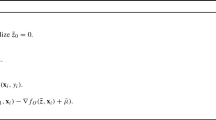Abstract
Standard support vector machine (SVM) achieves good generalization by maximizing margin and the leading optimization problem can be solved by quadratic programming (QP). Geometrically, such margin description benefits from closed-formed Euclidian distance formula between the support vectors to the decision plane (point-to-plane) based on L2 norm. However, for non-L2 norm learning machines, such as L1- or infinite-norm, due to their non-differentiability, it is difficult to obtain close-formed point-to-plane distance and thus rarely seen large margin classifiers based on other norms in literatures. In this paper, we proposed an infinite-norm large margin classifier, termed as InfLMC. Firstly, for any given points and a plane, the foresaid close-formed distance and projection formula, based on infinite nom, are mathematically described, and then, similar to L2-SVM, infinite norm margin can be directly derived. Thus, the proposed InfLMC is constructed by maximizing margin and simultaneously minimizing experience error. Furthermore, the leading optimization problem can be solved by a linear programming problem (LP) rather than QP in standard SVM. Finally, the experimental results on some artificial and UCI datasets show its performance in test correctness and running time-consume.



Similar content being viewed by others
References
Campbell K, Carpenter KL, Hashemi J, Espinosa S, Marsan S, Borg JS et al (2018) Computer vision analysis captures atypical attention in toddlers with autism. Autism. https://doi.org/10.1177/1362361318766247
Müller M, Casser V, Lahoud J, Smith N, Ghanem B (2018) Sim4CV: a photo-realistic simulator for computer vision applications. Int J Comput Vis 126(9):902–919
Wegner JD, Tuia D, Yang M et al (2018) Foreword to the theme issue on geospatial computer vision
Hertz JA (2018) Introduction to the theory of neural computation. CRC Press, Boca Raton
Domeniconi C, Gunopulos D, Peng J (2005) Large margin nearest neighbor classifiers. IEEE Trans Neural Netw 16(4):899–909
Huang K, Yang H, King I et al (2008) Maxi–min margin machine: learning large margin classifiers locally and globally. IEEE Trans Neural Netw 19(2):260–272
Yeung DS, Wang D, Ng WWY et al (2007) Structured large margin machines: sensitive to data distributions. Mach Learn 68(2):171–200
Lanckriet G, Ghaoui LE, Bhattacharyya C et al (2002) Minimax probability machine//Advances in neural information processing systems. 801–807
Suykens JAK, Vandewalle J (1999) Least squares support vector machine classifiers. Neural Process Lett 9(3):293–300
Fung GM, Mangasarian OL (2005) Multicategory proximal support vector machine classifiers. Mach Learning 59(1–2):77–97
Mangasarian OL, Wild EW (2006) Multisurface proximal support vector machine classification via generalized eigenvalues. IEEE Trans Pattern Anal Mach Intell 28(1):69–74
Lopez J, De Brabanter K, Dorronsoro JR et al (2011) Sparse LSSVMs with L0-norm minimization//Proc Eur Symp Artif Neural Netw, Comput Intell Mach Learn, pp 189–194
Zhu J, Rosset S, Hastie T, Tibshirani R (2003) 1-norm support vector machines. Adv Neural Inf Process Syst (NIPS 2003), Vancouver, British Columbia, Canda
Blanco V, Puerto J, Rodríguez-Chía AM (2017) On LP-support vector machines and multidimensional kernels. arXiv:1711.10332
Zou H, Yuan M (2008) The F∞-norm support vector machine. Stat Sin 18:379–398
Yan H, Ye Q, Yu DJ et al (2018) Least squares twin bounded support vector machines based on L1-norm distance metric for classification. Pattern Recogn 74:434–447
Rusu C, Gonzalez-Prelcic N, Heath RW Jr (2018) Algorithms for the construction of incoherent frames under various design constraints. arXiv:1801.09678
Egolf D, Chee R, Chowdhury G et al (2018) Super-resolution photoacoustic imaging of sparse absorbers using L1-norm minimization (Conference Presentation)//Photons Plus Ultrasound: Imaging and Sensing 2018. International Society for Optics and Photonics, pp 10494
Lee S, Jun CH (2018) Fast incremental learning of logistic model tree using least angle regression. Expert Syst Appl 97:137–145
Azaïs JM, De Castro Y, Mourareau S (2018) Power of the spacing test for least-angle regression. Bernoulli 24(1):465–492
Mangasarian OL (1999) Arbitrary-norm separating planefn1. Oper Res Lett 24(1–2):15–23
Nonlinear Programming (2014) Proceedings of a symposium conducted by the Mathematics Research Center, The University of Wisconsin, Madison, May 4–6, 1970. Elsevier, New York
Yang X.,Wang Y, Chen, Bin (2013) Study on several key problems in Mahalanobis measure learning and Geometric explanation. J Nanjing Univ (Nat Sci) 49(02):133–141 (In Chinese with English Abstract)
Blake C, Keogh E, Merz CJ (1998) UCI repository of machine learning databases. Department of Information and Computer Science, University of California, Irvine. http://www.ics.uci.edu/~mlearn/MLRepository.html
Kalscheur MM, Kipp RT, Tattersall MC et al (2018) Machine learning algorithm predicts cardiac resynchronization therapy outcomes: lessons from the COMPANION trial. Circulation 11(1):e005499
Wang SP, Zhang Q, Lu J et al (2018) Analysis and prediction of nitrated tyrosine sites with the mRMR method and support vector machine algorithm. Curr Bioinform 13(1):3–13
Blanco V, Puerto J, Rodríguez-Chía AM (2017) On LP-support vector machines and multi- dimensional Kernels. arXiv:1711.10332
Chen J (2010) Convex relaxations in nonconvex and applied optimization. PhD thesis, University of Iowa. http://ir.uiowa.edu/etd/654
Han T, Jiang D, Sun Y et al (2018) Intelligent fault diagnosis method for rotating machinery via dictionary learning and sparse representation-based classification. Measurement 118:181–193
Luo X, Yang X, Jiang C et al (2018) Timeliness online regularized extreme learning machine. Int J Mach Learn Cybernet 9(3):465–476
Ma X, Liu S, Hu S et al (2018) SAR image edge detection via sparse representation. Soft Comput 22(8):2507–2515
Acknowledgements
We thank the anonymous reviewers for their valuable comments and suggestions. This research was supported by Central Public-interest Scientific Institution Basal Research Fund (Grant No.CAFYBB2016SZ003), Natural Science Foundation of China (31670554 and 61871444), and the Jiangsu Science Foundation (BK20161527 and BK20171453).
Author information
Authors and Affiliations
Corresponding author
Additional information
Publisher’s Note
Springer Nature remains neutral with regard to jurisdictional claims in published maps and institutional affiliations.
Rights and permissions
About this article
Cite this article
Yang, H., Yang, X., Zhang, F. et al. Infinite norm large margin classifier. Int. J. Mach. Learn. & Cyber. 10, 2449–2457 (2019). https://doi.org/10.1007/s13042-018-0881-y
Received:
Accepted:
Published:
Issue Date:
DOI: https://doi.org/10.1007/s13042-018-0881-y




